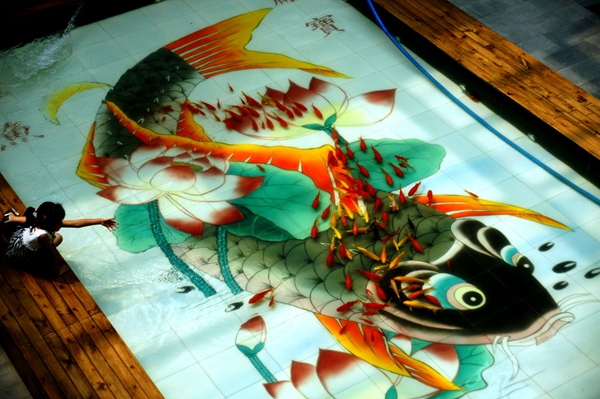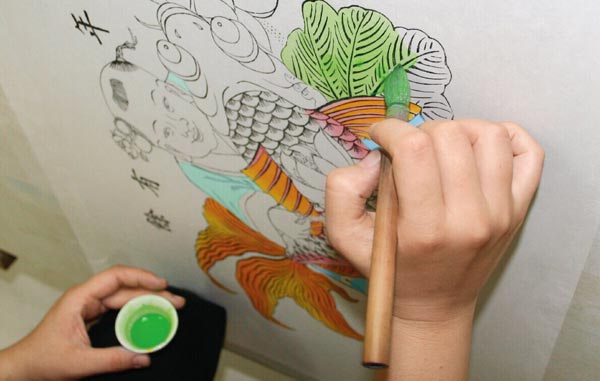Veteran artist aims to keep folk woodblock tradition alive

A girl plays by a pond decorated with a traditional-style New Year painting of a carp in the Yangliuqing Woodblock Prints Museum in Tianjin in July 2011, when the facility opened to visitors for free.[Photo provided to China Daily]
In a workshop around 20 kilometers from downtown Tianjin, 85-year-old Wang Xueqin takes out a wooden block and brushes ink on the board before he places rice paper onto it and rubs the surface with a special tool.
The outline of a picture featuring a big fish in a lotus pond appears.
With various types of brushes and hundreds of pigments, Wang then paints the body of the fish in red, its fat head in black and pink, eyes and tail in yellow, repeating the process three times. "In this way, colors become even brighter and do not fade as easily," he says.
Wang, an inheritor of Yangliuqing Woodblock Printing in North China's Tianjin city, is one of the few artists dedicated to producing fish paintings, which were traditionally hung on people's walls beside the water vats to express good wishes for the Chinese Lunar New Year.
Yangliuqing Woodblock prints were one of the most popular forms of New Year decorations in China, an industry which flourished in Tianjin and the surrounding areas during a period between the late Ming Dynasty (1368-1644) and the early Qing Dynasty (1644-1911).
In its heyday, more than 300 workshops created such artwork in the old canal-side market town of Yangliuqing in Tianjin. The canal helped transport the paintings to other places, boosting both local tourism and the economy.
"The prints contain abundant themes and content. Fish painting for water vats, featuring bright colors, was one of the most traditional types of Yangliuqing Woodblock print," Wang says, adding that it was popular among the common families.
Wang has witnessed the ups and downs of this traditional Chinese folk art.
He started making a living by selling the woodblock prints when he was a teenager.
"Families who had water vats usually bought one picture as a good omen," he says. "I walked through the streets with my father to advertise these pictures. I could earn up to three yuan (42 US cents) a day and eat some dumplings, a delicacy at that time."
His best years came after the reform and opening-up in the late 1970s. Every day, he carried rolls of printings and rode a bike to the bazaars in the downtown areas. "I sold about 5,000 pieces in a year."
However, the artwork has been gradually losing ground due to reasons including modern printing methods, a shortage of qualified successors and people's diversified options when it comes to furnishing their houses.
"The traditional artwork should redefine itself under the influence of multiculturalism and shifting modern aesthetic standards," says Luo Shuwei, a historian and researcher with the Tianjin Academy of Social Sciences.

A craftsperson paints a print featuring a plump baby holding a large fish with a lotus in the background-a classic image of Yangliuqing woodblock New Year prints. Yangliuqing Woodblock Printing was one of the most popular forms of New Year decorations in China, which flourished in Tianjin and the surrounding areas during a period between the late Ming Dynasty (1368-1644) and the early Qing Dynasty (1644-1911).[Photo provided to China Daily]
Now, Yangliuqing Woodblock Printing has become an art and is not unique to the Chinese Lunar New Year. Many collectors from nearby Beijing and Hebei province often purchase the paintings from Wang.
Wang has six apprentices and he is excited that his daughter is also willing to pick up the baton to pass down the craftsmanship.
"The job is tedious and tough, with a humble income," Wang says. He is trying to revive the age-old art of woodblock printing with carving chisels and woodcut knives. He has, however, added some new elements to the painting and he engraved six new woodblocks last year.
"Few people use water vats to store water now as they have better living conditions. However, I cannot let this art disappear either," Wang says.

Copyright © Tianjin Municipal Government.
All rights reserved. Presented by China Daily.
京ICP备13028878号-35



